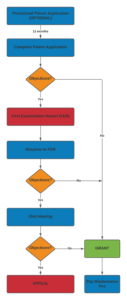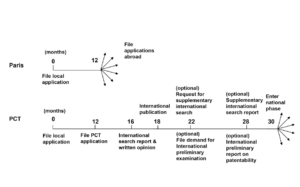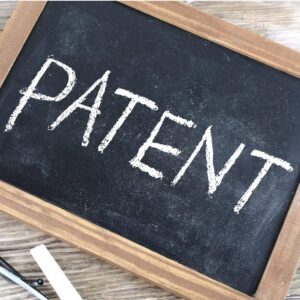Patent Rights – A Complete Overview
Introduction
The tumultuous patent litigations across the globe involving pharmaceuticals, software, automobiles, telecommunications, etc. have pushed the conversation about patents to the forefront. As a result of these patent litigations, many business owners are now interested in understanding the nuances of patents and protecting their inventions. Despite the key role of trademarks in making any industry reputable and good-willed, patents have tended to dominate the technology-oriented industries. Unfortunately, even today, many inventors fail to recognize the value of their work and publish without taking adequate steps to prevent infringement. Once you disclose your invention in the public domain without protecting it legally, you may lose all your rights over it. So in our efforts to raise awareness about patents, we have attempted to explain some of their basics.
What is a Patent?
The word “patent” comes from the Latin term “litterae patentes“, which means patent letter. From various available sources, it has been found that in countries like Italy, France, and England, such letters were used by monarchs to award exclusive rights to individuals to produce specific goods and services. With the advent of the Industrial Revolution, patents gained more prominence and following various modifications and amendments in different parts of the world, the advanced patent system as we see it today was developed. A patent is a form of intellectual property (IP) right. Primarily a patent may be referred to certain rights granted in lieu of an invention. A patent empowers the owner of the invention to prevent anyone from using his invention without his consent. So, for an owner of any invention, patenting is unarguably the best method for safeguarding his invention. Another noteworthy feature of patents is like other IP rights, patent rights are also territorial and available for a limited period of time. So, once an invention is developed, getting a patent should be the immediate step. For more details, you can check our extensive article on this URL: https://acuraip.com/what-is-a-patent/.
Rights of a Patentee
In India, the rights of a patentee are enshrined under Section 48 of the Patents Act, 1970. As per said Section, the rights of a patentee shall entail the power to prevent people who do not have his consent from doing the following activities:
- act of making the product,
- using the product,
- offering for sale of the product or selling or
- importing the product in India.
At this juncture, it is important to mention that while the patent rights accrue from the date of application, these rights can be enforced only after the grant of the patent. However, a patentee can seek damages from the infringers from the date of publication.
Advantages of a Patent
There are several advantages of getting a patent. They are as follows:
- Safeguarding the invention from copycats.
- A patent like any other IP right is a tradeable commodity, that you can assign or license either for a periodic royalty share or a lumpsum fee.
- A patent is very advantageous to gather investors. Firstly, it removes any doubt the investor may have regarding the genuineness of the invention. Secondly, the investor also feels secure as in case of an infringement, the patentee is not remediless. Therefore, having a patent gives you that much-needed edge in any business negotiations.
- Also, having a patent-pending/patented tag on any product helps in building trust in the minds of the consumer regarding the quality of the product.
What can be Patented?
The entire discussion related to patents revolves around the invention for which a patent is granted. All inventions are not granted patents. In order for a patent to be granted in India, an invention must meet certain statutory conditions. Amongst all other procedural and disclosure requirements, which are based on the “quid pro quo” system, an invention must be novel, have an inventive step, and have industrial applicability. Additionally, in India, the subject matter of the invention also should not be falling under Section 3 or Section 4 of the Patents Act, 1970. There are similar subject-matter requirements in other jurisdictions as well. You may also refer to the article “What Kind of Inventions Can be Patented?” for a detailed understanding of the requirements to be fulfilled for an invention to get a patent grant.
Since IP rights are important for businesses across the world, the World Trade Organization (WTO) has made sure that the law and process of protecting IP such as Patents and trademarks are similar across all signatory countries. Therefore, an invention mostly undergoes a similar examination process when patent applications are filed across multiple jurisdictions.
How do you get a Patent?
For getting a patent grant, the first and foremost step is to file a patent application before the patent office. Nowadays since all the procedures are digitized, e-fling of a patent application is the preferred route.
When the inventor himself wishes to get a patent, the application can be filed in his own name. In case the invention is the outcome of the R&D division of a company, the application is filed on behalf of the company. In this scenario, the details of the inventors are mentioned separately in requisite forms.
Types of Patent Applications:
The patent application can be divided into several categories, either depending on the route of a patent application or based on the type of specification.
Depending on the Route of the Patent Application:
Generally, an applicant can opt for various routes, i.e. whether to file the application only in his base country, or in some other countries as well. Depending on the route of the patent application, the following types of patent applications are available:
- Basic Application;
- Convention Application;
- Patent Cooperation Treaty (PCT) Application.
An application that is simply filed in the home or base country is called a basic application. When the application is filed under the Paris Convention to enter member states which are part of the Paris Convention, the application is referred to as a Convention application. Finally, the application which is filed under the PCT for ease of entering various jurisdictions is known as a PCT application.
Depending on the Type of Specification of the Patent Application:
At times, though the invention is ready, it has to undergo some testing or trials, or the final product or process is yet to be developed. In such a scenario, the patent system provides some flexibility to the applicant to file an application without giving a detailed description or specifications of the invention. Depending on the type of specification, the type of patent application has been categorized as:
- Provisional
- Complete /Non-provisional
So, when the invention is still in its raw form, or some studies and testing are yet to be conducted, an applicant may file a provisional application to secure his invention. Once the final invention is ready after filing the provisional application, the applicant can file the complete specification with all the details and preferred embodiments. The most important part of the complete specification is the patent claims on which the patent is mainly granted. The details of the important parts of the specification are provided in the article “ Patent Specification- Laws in India”.
Additionally, there are other types of applications such as patent of addition, divisional application, etc. For more details regarding the type of application, please refer to the article “Types of Patent Applications”.
Difference Between Provisional and Complete Specifications
The basic difference between a provisional and a complete specification is that a provisional is merely a general description of the invention, whereas a complete specification is a full and particular description of the invention. Therefore, when the applicant is not yet ready with the final invention, he can file a provisional application. Filing a provisional application provides the following advantages:
- The applicant gets one year period from the date of filing of the provisional application to completely develop the invention and file a complete specification.
- The applicant gets a patent-pending tag for his invention at a more economical and reasonable rate since the professional fee for drafting a provisional specification is much cheaper than a complete specification.
- Since the applicant has a pending patent tag, this increases the chances of getting more investments and provides benefits during business negotiations.
- In case the applicant feels that the product is not commercially viable, the applicant can always abandon the patent application without investing any further money and effort in it.
Patent Filing in India
Once a patent application is filed before the Patent Office, the application is published in the patent office journal. Thereafter, when the applicant files a request for examination, the application is examined by the concerned patent examiner, and an examination report (FER) is issued by the patent office. The applicant is required to respond to the examination report within six months of receiving the examination report. The deadline is extended to three more months. Once, the reply has been filed, the concerned Examiner and the Controller go through the same. In case, there are any outstanding objections, a hearing notice is issued to the applicant. On the date of the hearing, the patent agent on behalf of the applicant clarifies all the objections and provides arguments on behalf of the applicant. Within 15 days of the hearing, the applicant is required to file written submissions. Post filing of the written submissions, if the Controller is satisfied, the patent application is granted otherwise the application is refused.
In addition, to the general route, the prosecution of the patent application can be expedited by opting for the expedited route and paying the extra official fees. The article titled “Patent Filing Procedure in India” can be referred to for more details.

NB: This is a simplified flowchart created to provide basic understanding of the patent process. The flowchart does not include opposition proceedings.
What happens when a Patent Application is Refused?
After the entire prosecution of a patent application, the Controller either grants or refuses the patent application. In case of a refusal, if the applicant is not satisfied with the reasons for refusal, the applicant can file an appeal before the concerned High Court against such refusal. Previously, the appeals were preferred before the erstwhile Intellectual Property Appellate Board (“IPAB”). However, after the Tribunal Reforms Act, 2021 (initially Tribunal Reforms Ordinance, 2021) the IPAB was abolished and jurisdiction for hearing all the appeals and revocation petitions was conferred on the respective High Courts. Interestingly, the Delhi High Court, acting as a pioneer in this area has formulated an Intellectual Property Division for expediting the disposal of such appeals and revocation petitions.
Can a Patent be Revoked/Challenged?
Lastly, another noteworthy point about the patent system is whether a third party can challenge a patent application or a granted patent. The answer to this question is “Yes”. The Indian Patents Act, 1970 provides the following routes for challenging a patent application or a granted patent by any third party:
- Pre-grant Opposition;
- Post-grant Opposition;
- Revocation Proceedings.
A pre-grant opposition is filed before the patent is granted. Once the application is published, any person can challenge the application till the application is granted based on the grounds provided under Section 25(1) of the Indian Patents Act, 1970.
The other two proceedings are available only the patent is granted. Once a patent is granted, the patent grant is published in a journal. So, any person interested may challenge the patent grant within one year from the date of publication of the grant on the grounds provided under Section 25(2) of the Patents Act, 1970. Also, during the lifetime of the patent, any person interested can file a revocation petition before the concerned High Court challenging the grant of the patent on the grounds available under Section 64 of the Patents Act, 1970. While both the pre-grant and post-grant opposition proceedings take place before the Patent Office, the revocation proceedings are entirely heard by the concerned High Court.
We understand that after reading this you may be thinking that getting a patent grant is a tedious and daunting task. But remember, be it engineering solutions, product ideas, scientific publications, or academic papers, evaluating the possibility of protecting your intellectual property is the first step you should take to protect your interests. The daunting and tedious part of the patent process can be handled by patent agents. Also, remember that patents are not the only form of intellectual property. Your creation may be entitled to other forms of IP including copyrights, and industrial designs. In some cases, you may even consider keeping your solution a trade secret. To understand which form of IP suits your needs, you may go through the FAQs on patents from here, trademarks from here, copyrights from here, and industrial designs from here. Alternatively, it is always better to connect with an IP Attorney who can assist you and provide you with tailor-made solutions. You can talk to us so that we can suggest you the best solution.
International Patents
Patent rights are country-specific and thus, territorial in nature. There is no concept of international patents. Nevertheless, the World Intellectual Property Organization (“WIPO”) has come up with different solutions for individuals and companies who wish to extend their patent protection beyond their home country.
As already mentioned patent application (utility patent application) can be filed in multiple jurisdictions using two means:
- Paris Convention Filing (Convention Application)
- Patent Co-operation Treaty (PCT) Filing (PCT Application)
Convention Application or Paris Convention Filing
In Paris Convention Filing Process, an applicant has to file each application separately in each jurisdiction by claiming priority to the priority application (irrespective of whether the first filing was provisional or non-provisional). The deadline to file in each country is within 12-months from the priority date (date of first filing irrespective of whether the first filing was provisional or non-provisional).
Patent Cooperation Treaty (PCT) Application or PCT Filing
In PCT filing, a two-step phase is applicable, the first phase relates to international filing and the second phase relates to the national phase.
Phase I Filing
Phase I is called the international filing phase upon filing and payment of the initial phase. In the first phase or Phase I filing, the applicant files an international application (could be an initial/first filing or an application claiming priority over the first filed provisional application) at Receiving Office (RO) of his choice. WTO has authorized a few patent offices to act as ROs. For example, USPTO (USA), EPO (EU), JPO (Japan), IPOS (Singapore), IPO (India), etc., are some authorized ROs. The applicant must do the initial filing via one of these offices. The applicant should also select the list of jurisdictions where he wants to extend this PCT application during the second phase, i.e. National Phase (NP). The applicant is also required to select an International Search Authority (ISA) for examining the application. This ISA will be responsible for conducting a search and examination of the patent application. While pursuing a PCT applicant the applicant must pay the international filing fee, transmittal fee, and the international search fee. The search fee depends on the ISA you select and varies widely.
Phase II Filing
Upon completion of phase I, the applicant will receive a search report for his application from the chosen ISA. Then the applicant may proceed with prosecution in the chosen ISA after receiving the search report. If the applicant chooses to enter the national phase in other countries, he must do the same within 30 months of the priority date (first filing date, not the PCT filing date). Once the application enters the national phase, the applicant must pay the search/examination fee for each country and follow the usual prosecution process.
The advantages of PCT filing are as follows:
- Single filing at the initial stage.
- Saves money initially.
- 30 months from the priority date to enter the national stage. If the first filing was PCT, one gets 30 months to evaluate if the patent has a chance of being granted before entering the national phase in other countries.
As compared to a Convention application, in the PCT application, an applicant gets more time for entering different jurisdictions and can also cover more jurisdictions.
It is always advisable to go for a patentability search to make sure that the invention is novel and non-obvious. Upon determining that the invention is patentable, the applicant may proceed with drafting and filing the patent application.

TIMELINES FOR PARIS CONVENTION AND PCT FILING. SOURCE: WIPO
Patent Services provided by Acura IP
- Patentability search/opinion
- Invalidation search/opinion
- Freedom to operate search/opinion
- Patent Landscaping
- Patent Claim Mapping
- Provisional patent drafting and filing
- Complete or non-provisional patent drafting and filing
- Patent prosecution
- Patent hearings
- Patent opposition matters
- Appeal against refusal orders
- Patent Litigation


